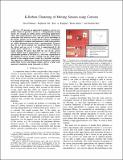| dc.contributor.author | Feldman, Dan | |
| dc.contributor.author | Gil, Stephanie | |
| dc.contributor.author | Knepper, Ross A. | |
| dc.contributor.author | Julian, Brian John | |
| dc.contributor.author | Rus, Daniela L. | |
| dc.date.accessioned | 2014-10-07T18:19:28Z | |
| dc.date.available | 2014-10-07T18:19:28Z | |
| dc.date.issued | 2013-05 | |
| dc.identifier.isbn | 978-1-4673-5643-5 | |
| dc.identifier.isbn | 978-1-4673-5641-1 | |
| dc.identifier.issn | 1050-4729 | |
| dc.identifier.uri | http://hdl.handle.net/1721.1/90592 | |
| dc.description.abstract | We present an approach to position k servers (e.g. mobile robots) to provide a service to n independently moving clients; for example, in mobile ad-hoc networking applications where inter-agent distances need to be minimized, connectivity constraints exist between servers, and no a priori knowledge of the clients' motion can be assumed. Our primary contribution is an algorithm to compute and maintain a small representative set, called a kinematic coreset, of the n moving clients.We prove that, in any given moment, the maximum distance between the clients and any set of k servers is approximated by the coreset up to a factor of (1 ± ε), where ε > 0 is an arbitrarily small constant. We prove that both the size of our coreset and its update time is polynomial in k log(n)/ε. Although our optimization problem is NP-hard (i.e., takes time exponential in the number of servers to solve), solving it on the small coreset instead of the original clients results in a tractable controller. The approach is validated in a small scale hardware experiment using robot servers and human clients, and in a large scale numerical simulation using thousands of clients. | en_US |
| dc.description.sponsorship | Micro Autonomous Consortium Systems and Technology (United States. Army Research Laboratory (Grant W911NF-08-2-0004)) | en_US |
| dc.description.sponsorship | United States. Air Force (Contract FA8721-05-C-0002) | en_US |
| dc.language.iso | en_US | |
| dc.publisher | Institute of Electrical and Electronics Engineers (IEEE) | en_US |
| dc.relation.isversionof | http://dx.doi.org/10.1109/ICRA.2013.6630677 | en_US |
| dc.rights | Creative Commons Attribution-Noncommercial-Share Alike | en_US |
| dc.rights.uri | http://creativecommons.org/licenses/by-nc-sa/4.0/ | en_US |
| dc.source | MIT web domain | en_US |
| dc.title | K-robots clustering of moving sensors using coresets | en_US |
| dc.type | Article | en_US |
| dc.identifier.citation | Feldman, Dan, Stephanie Gil, Ross A. Knepper, Brian Julian, and Daniela Rus. “K-Robots Clustering of Moving Sensors Using Coresets.” 2013 IEEE International Conference on Robotics and Automation (May 2013). | en_US |
| dc.contributor.department | Lincoln Laboratory | en_US |
| dc.contributor.department | Massachusetts Institute of Technology. Computer Science and Artificial Intelligence Laboratory | en_US |
| dc.contributor.department | Massachusetts Institute of Technology. Department of Electrical Engineering and Computer Science | en_US |
| dc.contributor.department | Massachusetts Institute of Technology. School of Engineering | en_US |
| dc.contributor.mitauthor | Feldman, Dan | en_US |
| dc.contributor.mitauthor | Gil, Stephanie | en_US |
| dc.contributor.mitauthor | Knepper, Ross A. | en_US |
| dc.contributor.mitauthor | Julian, Brian John | en_US |
| dc.contributor.mitauthor | Rus, Daniela L. | en_US |
| dc.relation.journal | Proceedings of the 2013 IEEE International Conference on Robotics and Automation | en_US |
| dc.eprint.version | Author's final manuscript | en_US |
| dc.type.uri | http://purl.org/eprint/type/ConferencePaper | en_US |
| eprint.status | http://purl.org/eprint/status/NonPeerReviewed | en_US |
| dspace.orderedauthors | Feldman, Dan; Gil, Stephanie; Knepper, Ross A.; Julian, Brian; Rus, Daniela | en_US |
| dc.identifier.orcid | https://orcid.org/0000-0001-5473-3566 | |
| dc.identifier.orcid | https://orcid.org/0000-0002-3964-2049 | |
| dspace.mitauthor.error | true | |
| mit.license | OPEN_ACCESS_POLICY | en_US |
| mit.metadata.status | Complete | |
